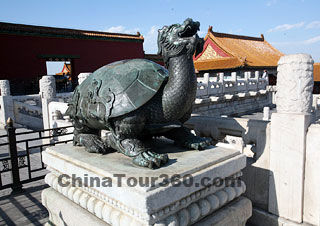Built in 1420, Hall of Supreme Harmony (Taihedian), also known as 'Jinnuandian' (Hall of the Imperial Throne), is the largest wood-structure palace existing in China. It is located at an important position on the south-north main axis of the Forbidden City. It was initially named Fengtian Palace in the reign of Emperor Yongle, and was renamed Huangji Hall in 1582 of Emperor Jiajing’s reign in the Ming Dynasty (1368 - 1644). Later in the Qing Dynasty (1644 - 1911), it was again renamed Hall of Supreme Harmony. The buildings in the hall were also destroyed and rebuilt several times, and the present was built in 1695 under the reign of Emperor Kangxi.
|
|
In ancient China, the Hall of Supreme Harmony was used for holding all kinds of ceremonies. In the Ming and Qing dynasties, there were a total of 24 emperors holding many grand ceremonies in this hall, such as a new emperor's accession, wedding ceremony, appointing his empress, and dispatching generals into fields of war. Every year, the emperor would also receive the respects from the officials and generals on his birthday, the New Year’s Day and Winter Solstice here.
The Hall of Supreme Harmony is the highest-grade and the largest architecture in the Forbidden City, built with double-eave hip roof that is the top-level palace roof in the Qing Dynasty. Its roof was decorated with carved dragons and phoenixes. The hall is wide and deep, standing on a white marble base of 35.05 meters (115 feet) high. The base is surrounded by rails, under which were built with stone-carved dragon heads for drainage. During the rainy season, you can witness a spectacle of thousands of dragons spouting water. There is a wide platform in front of the door of the hall, on which were set up with one sundial (an ancient timer), one Jialiang (an ancient measurement instrument), one pair of bronze cranes, one pair of bronze turtles and 18 bronze tripods. The sundial and Jialiang represent the imperial power, while the cranes and turtles symbolize longevity. There is also a large square for the officials to offer respects to the emperor in front of the hall, which has a capacity of ten thousand people.
The inside of the Hall of Supreme Harmony was luxuriously decorated, too. The beams were painted with the highest-grade colored paintings of the Qing palace. The doors and windows were fitted into diamond-shape patterns, with embossed designs of clouds and dragons at the bottom and gold-plated bronze leaves carved with dragon patterns at the joints. The ground was paved with 4,718 golden-like bricks especially made from the high-quality earth of Suzhou. The bricks appear light black, bright and lustrous, but they don’t feel slippery at all. There are a total of 72 pillars holding the hall, of which the one holding the roof beam has a height of 47 feet.
In addition, there is a nine-dragon gold lacquer throne in the hall, on both sides of which were set up with 6 pillars decorated with golden clouds and dragons. In front of the throne, there are auspicious and symbolic animal sculptures, such as the crane for longevity, luduan for luck and elephant for the stability of the state and the regime. Above the throne, there is a hollow place carved with a dragon with a bright pearl in its mouth. The pearl was said to be able to identify whether the new emperor was the one who was chosen by the former emperor and the one who was competent for the throne. If not, the pearl would drop down and kill him.
![]() Go to the Next Attractions: Gate of Heavenly Purity & Office of Grand Council
Go to the Next Attractions: Gate of Heavenly Purity & Office of Grand Council










